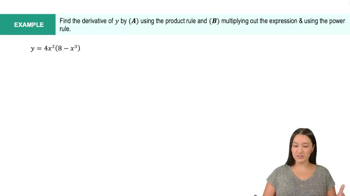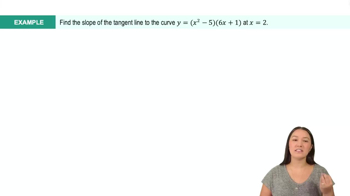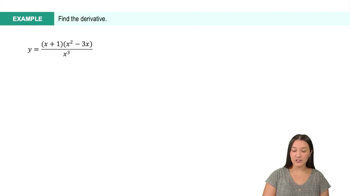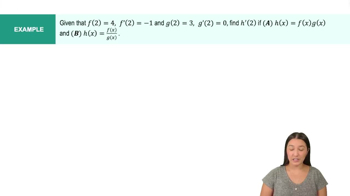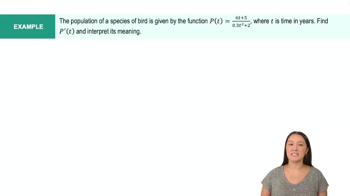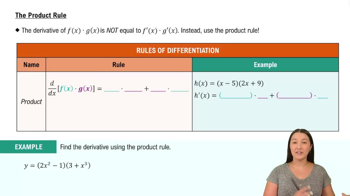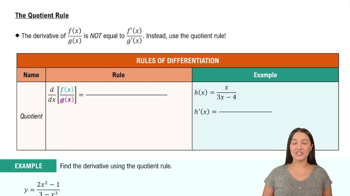Table of contents
- 0. Functions7h 52m
- Introduction to Functions16m
- Piecewise Functions10m
- Properties of Functions9m
- Common Functions1h 8m
- Transformations5m
- Combining Functions27m
- Exponent rules32m
- Exponential Functions28m
- Logarithmic Functions24m
- Properties of Logarithms34m
- Exponential & Logarithmic Equations35m
- Introduction to Trigonometric Functions38m
- Graphs of Trigonometric Functions44m
- Trigonometric Identities47m
- Inverse Trigonometric Functions48m
- 1. Limits and Continuity2h 2m
- 2. Intro to Derivatives1h 33m
- 3. Techniques of Differentiation3h 18m
- 4. Applications of Derivatives2h 38m
- 5. Graphical Applications of Derivatives6h 2m
- 6. Derivatives of Inverse, Exponential, & Logarithmic Functions2h 37m
- 7. Antiderivatives & Indefinite Integrals1h 26m
- 8. Definite Integrals4h 44m
- 9. Graphical Applications of Integrals2h 27m
- 10. Physics Applications of Integrals 2h 22m
3. Techniques of Differentiation
Product and Quotient Rules
Problem 3.R.96b
Textbook Question
{Use of Tech} Beak length The length of the culmen (the upper ridge of a bird’s bill) of a t-week-old Indian spotted owlet is modeled by the function L(t)=11.94 / 1 + 4e^−1.65t, where L is measured in millimeters.
b. Use a graph of L′(t) to describe how the culmen grows over the first 5 weeks of life.
 Verified step by step guidance
Verified step by step guidance1
First, understand that L(t) is a function that models the length of the culmen of an owlet over time. The function is given as L(t) = \(\frac{11.94}{1 + 4e^{-1.65t}}\). Our task is to analyze the growth rate of the culmen by examining the derivative L'(t).
To find L'(t), we need to differentiate L(t) with respect to t. This involves using the quotient rule for differentiation, which is given by \(\frac{d}{dt}\left(\frac{u}{v}\right) = \frac{v \cdot u' - u \cdot v'}{v^2}\), where u = 11.94 and v = 1 + 4e^{-1.65t}.
Calculate the derivatives u' and v'. Since u is a constant, u' = 0. For v, use the chain rule to find v' = \(-4 \cdot (-1.65) \cdot e^{-1.65t}\). Simplify this to v' = 6.6e^{-1.65t}.
Substitute u, u', v, and v' into the quotient rule formula to find L'(t). This will give you the expression for the rate of change of the culmen length with respect to time.
Finally, use a graphing tool to plot L'(t) over the interval from t = 0 to t = 5. Analyze the graph to describe how the growth rate of the culmen changes over the first 5 weeks. Look for trends such as increasing, decreasing, or constant growth rates.
 Verified video answer for a similar problem:
Verified video answer for a similar problem:This video solution was recommended by our tutors as helpful for the problem above
Video duration:
5mPlay a video:
Was this helpful?
Key Concepts
Here are the essential concepts you must grasp in order to answer the question correctly.
Derivative
The derivative of a function measures the rate at which the function's value changes as its input changes. In this context, L'(t) represents the growth rate of the culmen length over time, indicating how quickly the length is increasing or decreasing at any given moment.
Recommended video:

Derivatives
Graphing Functions
Graphing functions involves plotting the values of a function on a coordinate system to visualize its behavior. For L'(t), the graph will show how the growth rate of the culmen changes over the first five weeks, helping to identify periods of rapid growth or stagnation.
Recommended video:

Graph of Sine and Cosine Function
Exponential Functions
Exponential functions are characterized by a constant base raised to a variable exponent, often representing growth or decay processes. The function L(t) includes an exponential term, which influences the growth pattern of the culmen length, particularly in the early stages of the owlet's life.
Recommended video:
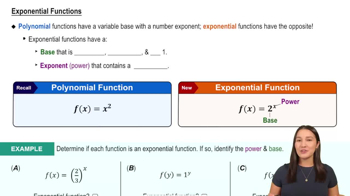
Exponential Functions
Related Videos
Related Practice



